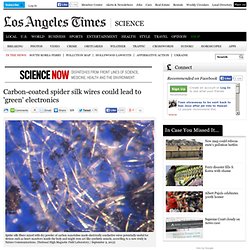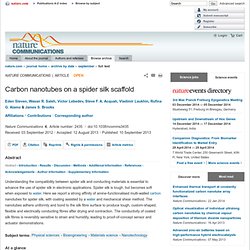

Carbon-coated spider silk wires could lead to 'green' electronics. Here are two things you might not expect to see together: spider silk coated in carbon nanotubes.

This hybrid material is stretchy, super strong and can shrink and grow with humidity, making it potentially very useful for sensors and flexible electronics – and scientists made it by rubbing it between their fingers. This nanotube-coated spider silk, described in the journal Nature Communications, could be useful for devices such as heart monitors inside the body and might even act like synthetic muscle. Spider silk is well known as a biological Holy Grail of fabrics: It's a super strong polymer that’s also remarkably flexible and completely biodegradable, and it expands and contracts in response to humidity. Some researchers have studied its biomedical uses inside the body, too.
But little work has been done on using it to send electrical signals, said lead author Eden Steven, a materials scientist at Florida State University in Tallahassee. There are a few drawbacks. Carbon nanotubes on a spider silk scaffold. MagLab News: MagLab’s Spider-Man follows nature’s lead: When spider silk meets carbon nanotubes. MagLab’s Spider-Man Follows Nature’s Lead Posted: September 11, 2013Contact: Kathleen Laufenberg (850) 644-5397; laufenberg@magnet.fsu.edu TALLAHASSEE, Fla. — Simple methods can result in surprising and environmentally friendly high-tech outcomes.

MagLab physicist Eden Steven. That’s part of what MagLab physicist Eden Steven discovered during his innovative experiments with spider silk and carbon nanotubes, the results of which are now published in Nature Communications, a high-quality online journal dedicated to biological, physical- and chemical-science research. “If we understand basic science and how nature works, all we need to do is find a way to harness it,” Steven says. Steven — the lead investigator on the paper “Carbon nanotubes on a spider silk scaffold” — collaborated with six other scientists, including Florida State University Physics Department Chair James Brooks and Fulbright scholar and Iraqi physicist Wasan Saleh.
---by Kathleen Laufenberg. Carbon nanotubes on a spider silk scaffold : Nature Communications. Water-based f-CNT coating of SS fibres We discovered that by mixing a bundle of dragline SS fibres (~2 cm long) with a dry powder of f-CNTs (Methods section), applying a few drops of water, and then pressing and shearing the mixture between two Teflon (Polytetrafluoroethylene) sheets, the fibres turned very black, and when dried, contracted to a well-defined geometry where the silk fibres were uniformly coated with nanotubes (Fig. 1).

The neat bundle contained multiple dragline silk fibres in their natural double-stranded arrangement (each strand has a diameter of ~4 μm), all of which were coated simultaneously. After the coating process, the dragline silk fibres were well separated into individually coated single-strand fibres (referred to as single fibres for the rest of the paper), accompanied by small isolated f-CNT aggregates (Supplementary Fig. S1). A neat SS bundle is mixed with a dry f-CNT powder. Full size image (102 KB) (a) SEM image of f-CNT-SS.
Full size image (164 KB)